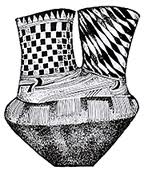After the settlement of the different Indo-European tribes, part of them, i.e. the Indo-Iranian tribes, remained in the steppes of southern Ukraine and Crimea. Indo-Iranians, or Cimmerians, who lived in the territory of Ukraine became the first people in Eastern Europe to be mentioned in a written source, the “Iliad” by the Greek poet Homer. They had long swords and attacked settlements in modern central Ukraine.
ancient-origins.net/news-history-archaeology/discovered-great-wall-siberia-dating-1st-millennium-bc Giant ramparts guarded Altai Mountains against attack from the north, says leading archaeologist Professor Andrey Borodovsky. The wall complex – now almost hidden to the naked eye – is believed to date from a long era that also saw such constructions as the Great Wall of China and Hadrian’s Wall. All the impressive defensive lines in Eurasia were built in the period from the beginning of the first millennium BC up to the opening half of the first millennium AD. This is the era of late Bronze Age and early Iron Age, including the Hunnish time on the eve of the Great Migration of Nations. In the same series of mammoth defensive structures is the Serpent’s Wall [an ancient system of earthen fortifications that stretch across Ukraine, from the town of Zmiiv in the east to Podolia in the west, the beginning of the erection of which dates back to the late Bronze Age.
globalsecurity.org/military/world/ukraine/serpent-walls In Ukraine on the general classification walls geographically divided into eleven groups:
- Lower Trojans wall – is located in the Bessarabia, stretching from the Gulf of villages to the city of Belgorod-Dniester.
- Upper wall Trojans – begins near the town of Bendery (Moldova) and extends to the river Prut continuous line, then turns sharply and connects the river with the Danube-Black Sea estuaries Yalpuh, Kotlabuh Sasyk.
- Trojan walls Dniester – a system located between the cities of Ternopil and Kamenetz-Podolsk. Have an intermittent character. They consist of two levels of the central chain and randomly scattered walls (some of them are even in Bukovina).
- Dragon walls Volyn – generalization title for a vast number of small-size and length of wall contained in the quadrangle Lviv, Lutsk, Rivne, Ternopil.
- Dragon walls skirts – the name of solid wall that extends from the mean flow of the river Bug to the central regions of the Cherkasy region and a small number of smaller walls in the same area.
- Dragon walls of Kyiv – Ukraine’s largest system of fortifications on the right bank, which consists of walls of different heights and lengths. It owns first place in Ukraine by total length.
- Dragon walls Pereiaslav – system of fortifications near the present city Perejaslav-Khmelnitsky Kiev region.
- Posullya dragon walls – the name of a wide wall that extends along the right bank of the river Sula from its mouth to the mean flow and its branches, reaching almost to the city of Sumy.
- Dragon walls Poltava – two intermittent wall located right on the banks of the river Vorskla and Horol.
- Dragon walls of Kharkiv – only two strong redoubts length of 20 and 25 kilometers near Kharkov.
- Crimean wall – system of fortifications between the Azov and Black Sea, the Kerch Peninsula. In the middle of the first millennium BC Herodotus wrote that the protection of the Scythians locals dug a wide ditch and rampart built by Tavriykih Meotiyskoho mountains to the sea. Val called the Cimmerian.
It is generally called the serpent mounds remains wall rivers Even, Red, Trubezh, Stugna and Ros. These walls today reach places fifteen feet (which they were in the old days) Height and several tens of kilometers in length. These walls are really the biggest in Ukraine and kept in good condition, but in other areas walls are called the dragon. In some areas worn walls Ukraine and other names that are characteristic only to specific areas – Large wall, Little, Brown, Ottoman, Polovtsian, trenches, Pereyma, Turkish dam. Paradoxically, sometimes the same wall at one site is called the dragon and the other side is called Trojans.

South of Kiev are the defense walls called Zmievy Valy (“The Snake / Serpent / Dragon Walls” – semantic closeness in Slavic cemented the connection of “snake” and “dragon” ). Although the time (or times) of their construction is much debated, the popular, i.e. folk name by which they are known dates from the era of Kievan Rus’.

Serpent’s Wall (Ukrainian: Змієві вали, romanized: Zmiievi valy is an ancient system of earthen earthworks (valla) located in the middle Dnieper Ukraine (Naddniprianshchyna)[1] that stretch across primarily Kyiv Oblast, Ukraine. They seem to be similar in purpose and character to Trajan’s Wall situated to the southwest in Bessarabia. The remaining ancient walls have a total length of 1,000 km and constitute less than 20% of the original wall system.[1] The ancient walls were built between the 2nd century BC and 7th century AD, according to carbon dating. There are three theories as to what peoples built the walls: either the Sarmatians against the Scythians, or the Goths of Oium against the Huns, or the Early East Slavs against the nomads of the southern steppes. In Slavic culture, the warlike nomads are often associated with the winged dragon, hence the name.

The Upper Trajan’s Wall is the modern name given to a fortification located in the central area of modern Moldavia. Some scholars consider it was built in the third/fourth century by the Germanic Greuthungi to defend their borders against the Huns.[1] It may also have been called Greuthungian Wall in later Roman accounts. Athanaric’s Wall, also called Lower Trajan’s Wall or Southern Trajan’s Wall, was a fortification line probably erected by Athanaric (the king of the Thervingi), between the banks of river Gerasius (modern Prut) and the Danube to the land of Taifali (modern Oltenia). Most probably, Athanaric’s Wall has reused the old Roman limes called Limes Transalutanus.[1]

The Cimmerians were a nomadic Indo-European people, who appeared about 1000 BC.[3] Originating in the Pontic-Caspian steppe, the Cimmerians subsequently migrated into Southwest Asia and into Central and Southeast Europe. While the Cimmerians (R1B) were often described by contemporaries as culturally Scythian, they may have differed ethnically from the Scythians (R1A) proper, who also displaced and replaced the Cimmerians.[4] The Cimmerians were most likely a nomadic Iranian people of the Eurasian Steppe.[6][9][10][5][11] Other suggestions for the ethnicity for the Cimmerians include the possibility of them being Thracian,[12] or Thracians with an Iranian ruling class, or a separate group closely related to Thracian peoples. The social structure of the Cimmerians, according to Herodotus, comprised two groups of roughly equal numbers: the Cimmerians proper, or “commoners”, and the “kings” or “royal race” – implying that the ruling classes and lower classes originally constituted two different peoples (or castes), who retained distinct identities as late as the end of the 2nd millennium BCE. Hence the “kings” may have originated as an element of an Iranian-speaking people (such as the Scythians), who had imposed their rule on a section of the people of the Catacomb culture,[15] i.e. the “commoners”. Hence the subsequent Cimmerian culture has been more strongly associated with the Srubnaya (19th-15th centuries BCE) and/or Belozerskaya (12th-10th centuries BCE) cultures.
The Scythians migrated from Central Asia to southern Russia in the 8th – 7th C. BCE. Like the Thracians, Celts, and Greeks, the Scythians were descendants of Indo-European-speaking steppe nomads from Central Eurasia, but unlike them, they belonged to an eastern group. They spoke an Indo-Iranian language. In the eighth century BCE, they started on their journey to the west, where they took over the areas that had once been inhabited by the Cimmerians. The term Thraco-Cimmerian (thrako-kimmerisch) was first introduced by Romanian archaeologist and historian Ion Nestor in the 1930s. It reflects a “migrationist” tendency in the archaeology of the first half of the 20th century to equate material archaeology with historical ethnicities. Nestor intended to suggest that there was a historical migration of Cimmerians into Eastern Europe from the area of the former Srubna culture, perhaps triggered by the Scythian expansion, at the beginning of the European Iron Age. This “migrationist” or “invasionist” theory, assuming that the development of the mature Hallstatt culture (Hallstatt C) was triggered by a Cimmerian invasion, was the scholarly mainstream until the 1980s. 1600 years BC East of Caspian sea was an area inhibited by Dahae-Scythian related people also descendants of *Srubnaya* culture, as Saka(tribus Sakae) from area North of Caspian and Scythians. They moved in waves into the area North of Black sea till 7th century BC temporarily submiting Cimmerians, who later were left only in Crimea, which got it name from them.
The Scythians arrived in Dacia in the sixth century BCE and settled among the Getae, while others moved on, across Romania, to the plains of Hungary.
Unii spun ca cimerienii ar fi stapânit toate aceste pamânturi începând din veacul al XVI-lea înainte de Hristos, dar datarea este, se pare mult exagerata, fiind mai logic de localizat undeva între secolele XII-VIII î.Hr.
Cert este faptul ca în secolul VIII î.Hr. ei sunt alungati din stepa nord pontica si din celelalte tinuturi din jurul Marii Negre de un alt popor, cel al scitilor, aflati în plin apogeu. Sub presiunea scita, cimerienii îsi abandoneaza vechile tinuturi si pornesc în exod, ajungând în zone îndepartate ale Asiei.
Vor ataca mai întâi Asiria iar regele Sargon al II-lea va fi ucis de catre ei. În jurul anului 695 i.Hr. cimerienii cuceresc Frigia iar celebrul si bogatul rege Midas, se otraveste pentru a nu fi capturat.
Cimerienii ataca mai târziu regatul asirian Urartu si pe regele acestora Esarhaddon (Asshardaron), fiul lui Senacherib si nepot al defunctului Sargon II. Ajutat de sciti, Asshardaron îi învinge în batalia de la Hubushna, din anul 673 î.Hr.
Treptat, cimerienii se retrag si vor continua sa lupte împotriva regatelor din Asia Mica, cum este cazul Lidiei. Cu timpul, cimerienii (divizati si întinsi pe zone vaste) devin din ce în ce mai slabi. Sunt înfrânti de neamuri noi, mai puternice sau sunt asimilati de catre acestea.
Nu dispar cu totul. In întreaga Europa exista neamuri (mai ales în Nord) care si-au descoperit (real sau nu) un filon cimeric. Merovingienii, stramosii regatului franc afirmau în secolele VII – VIII d.Hr. ca se trageau din tribul sicambrilor (sugambri), un grup de cimerieni veniti cu mii de ani în urma de la Gurile Dunarii, din Dobrogea noastra.












